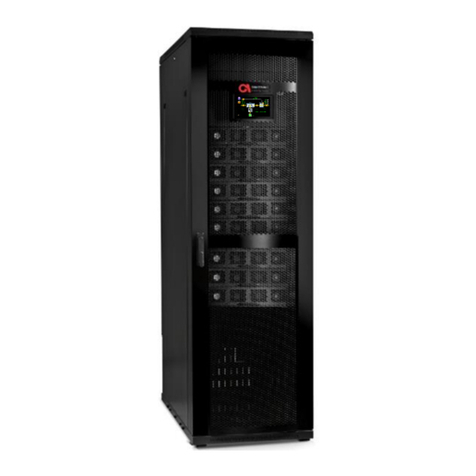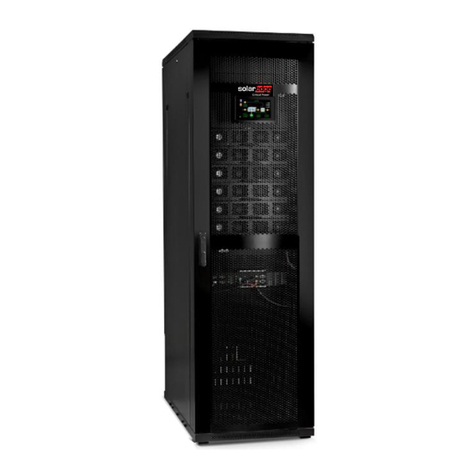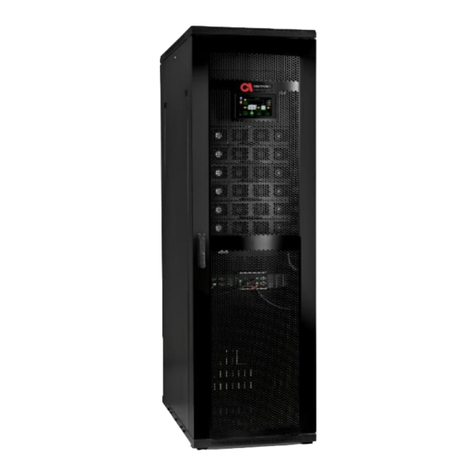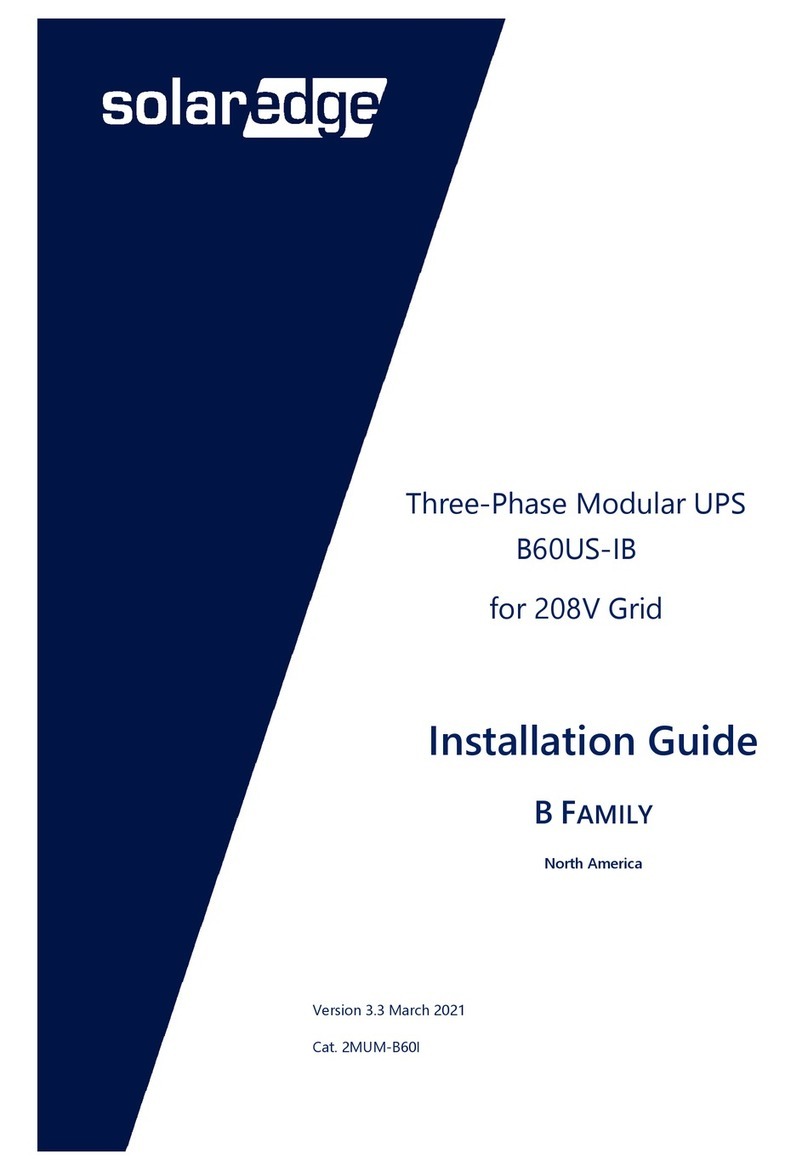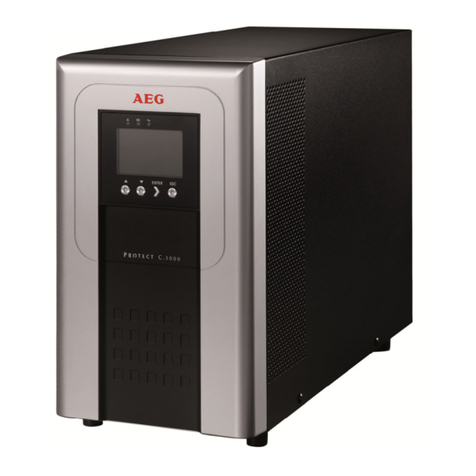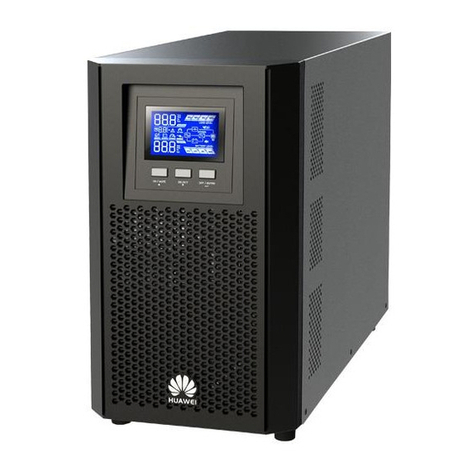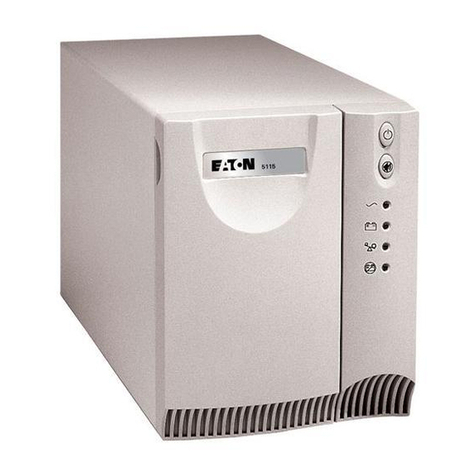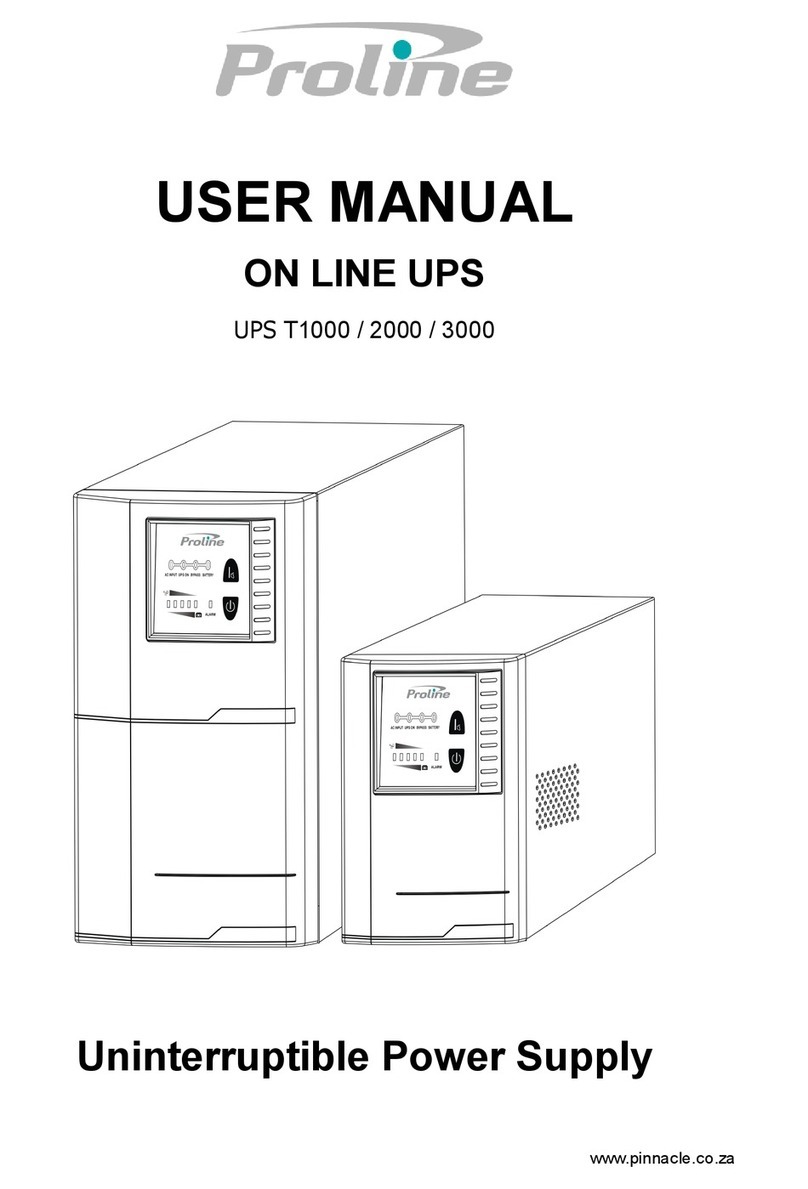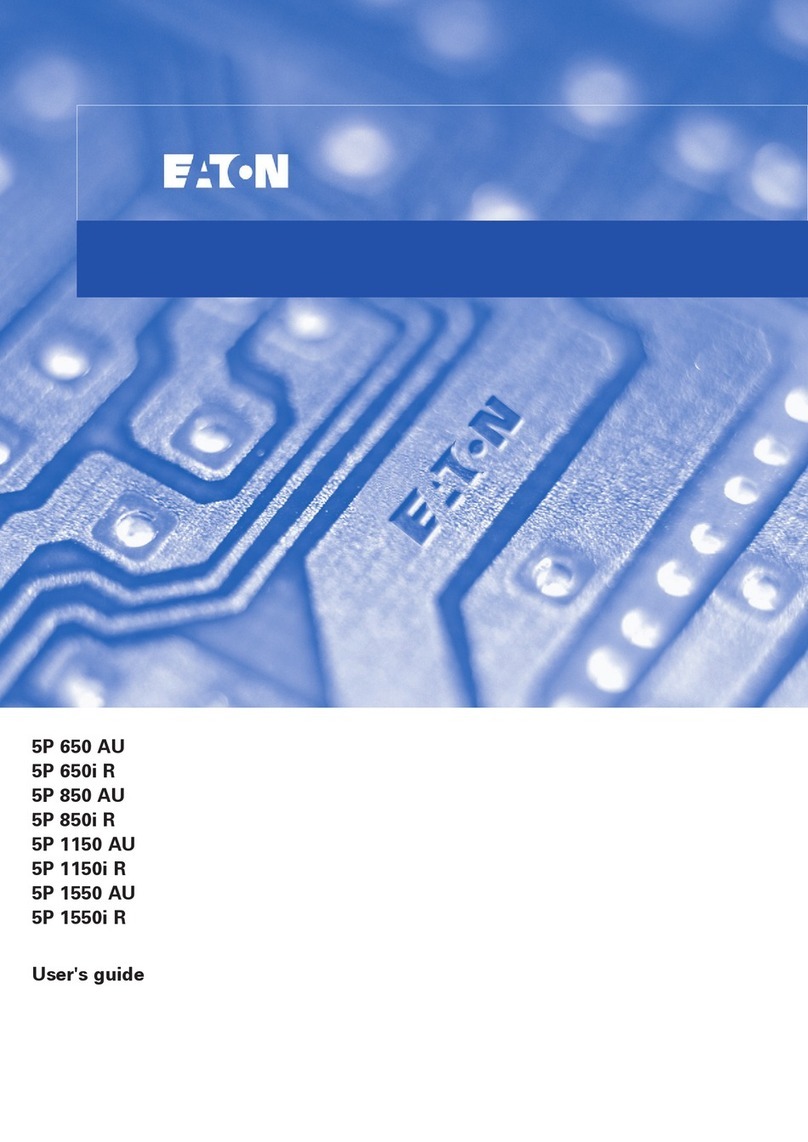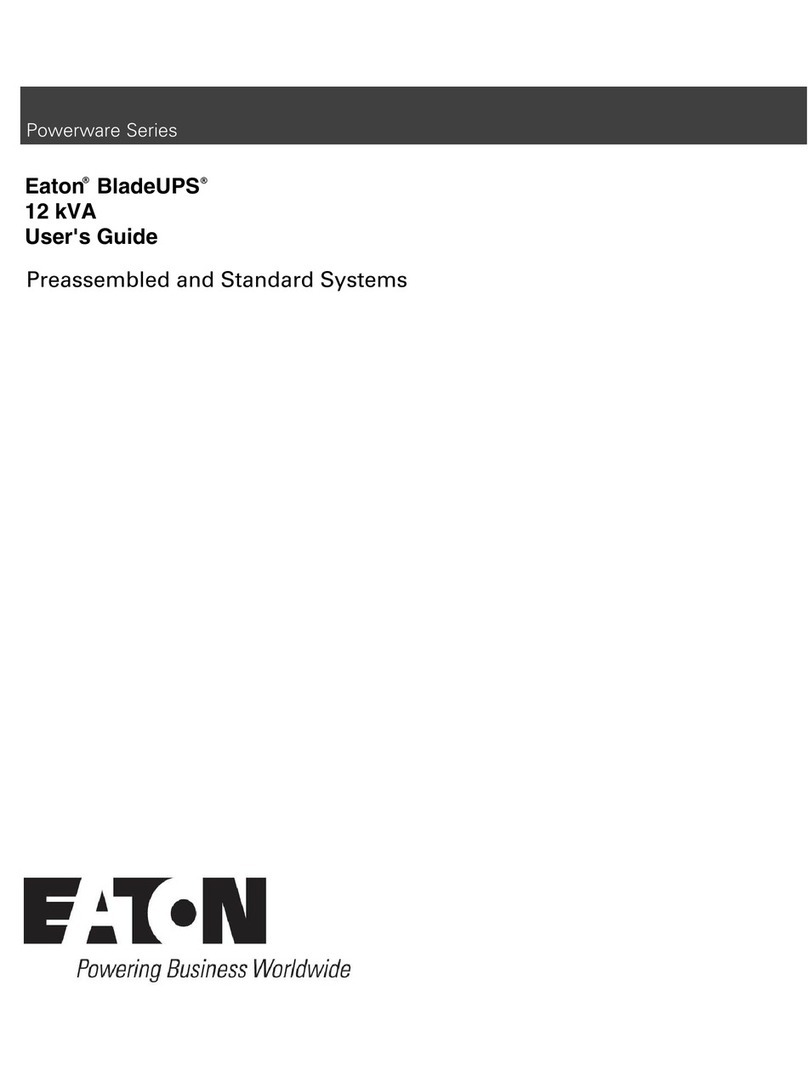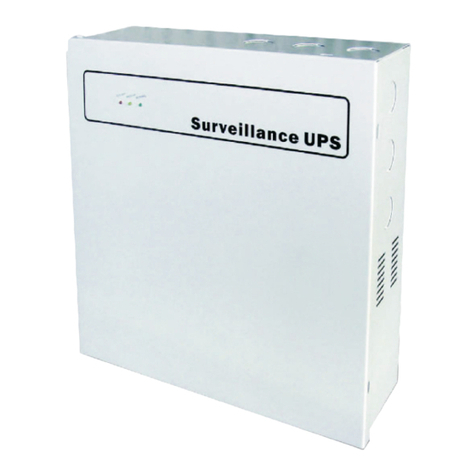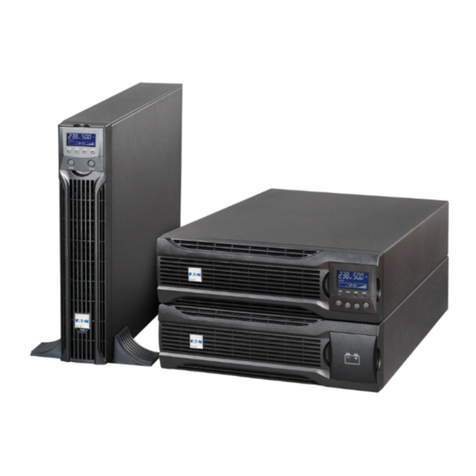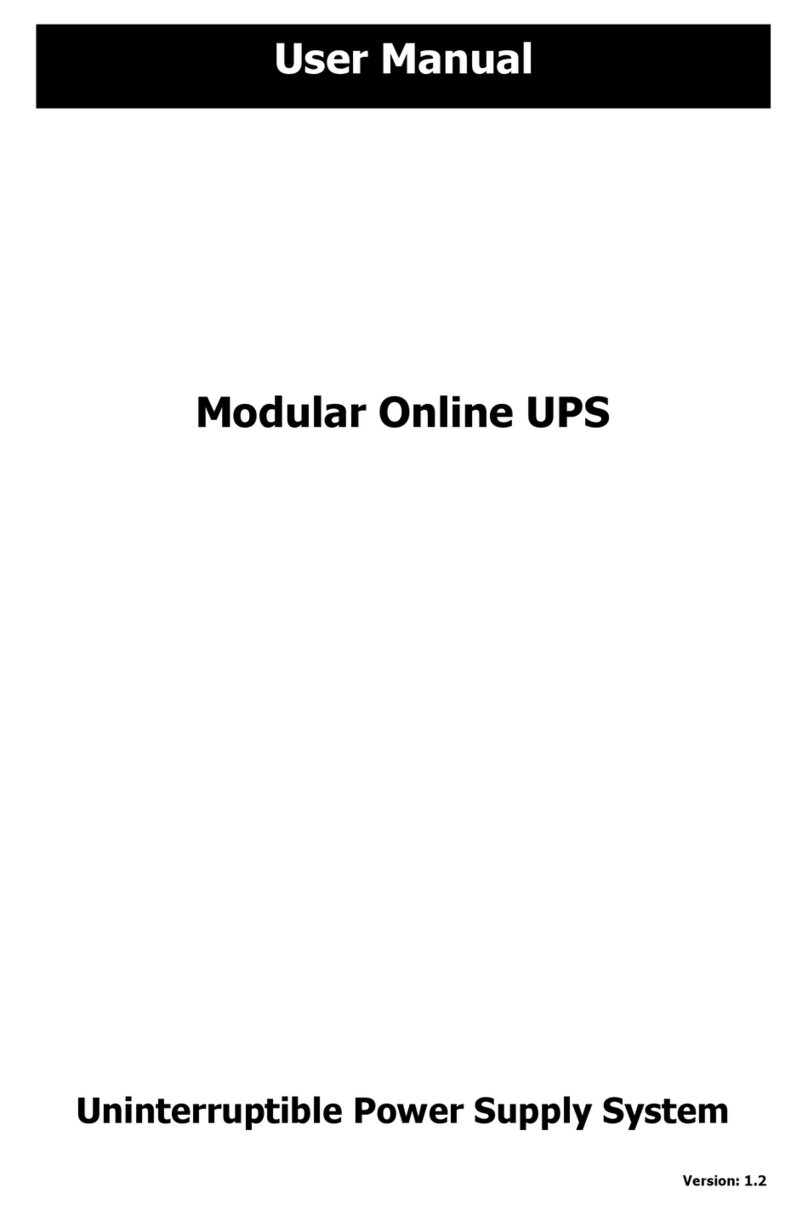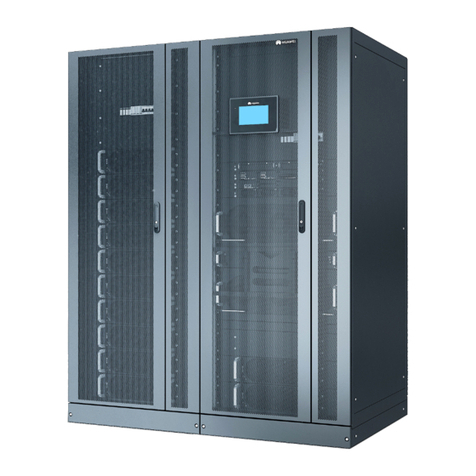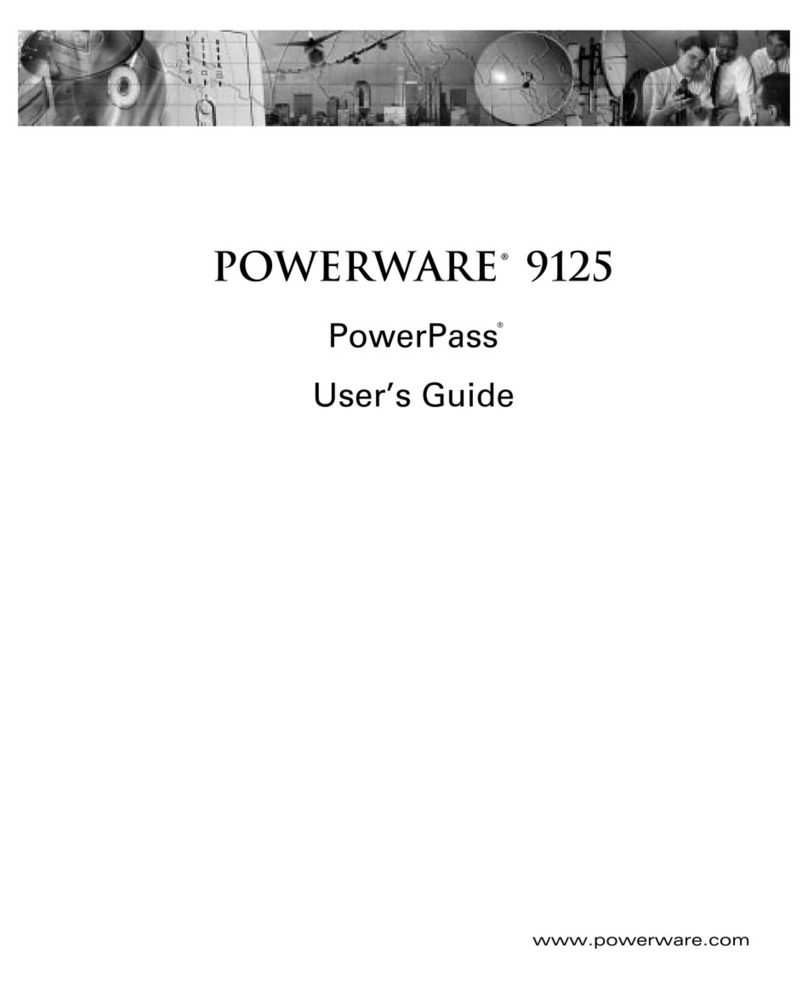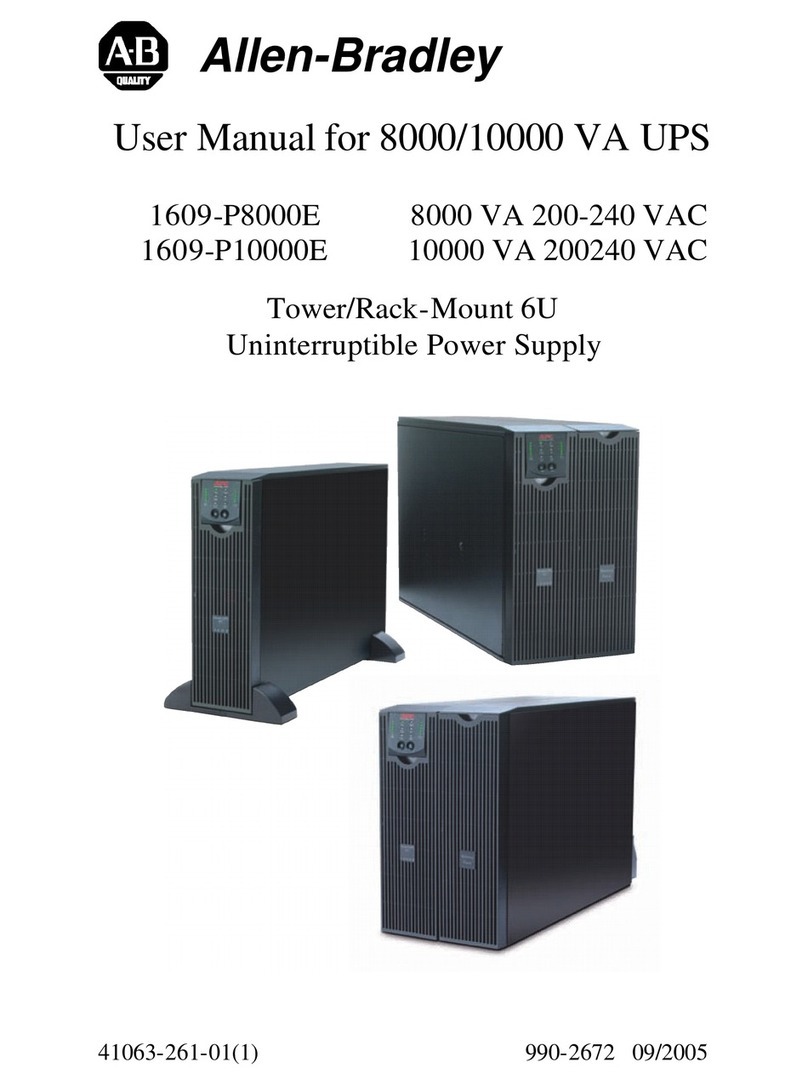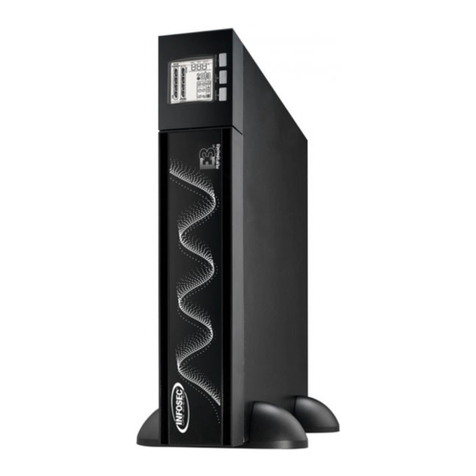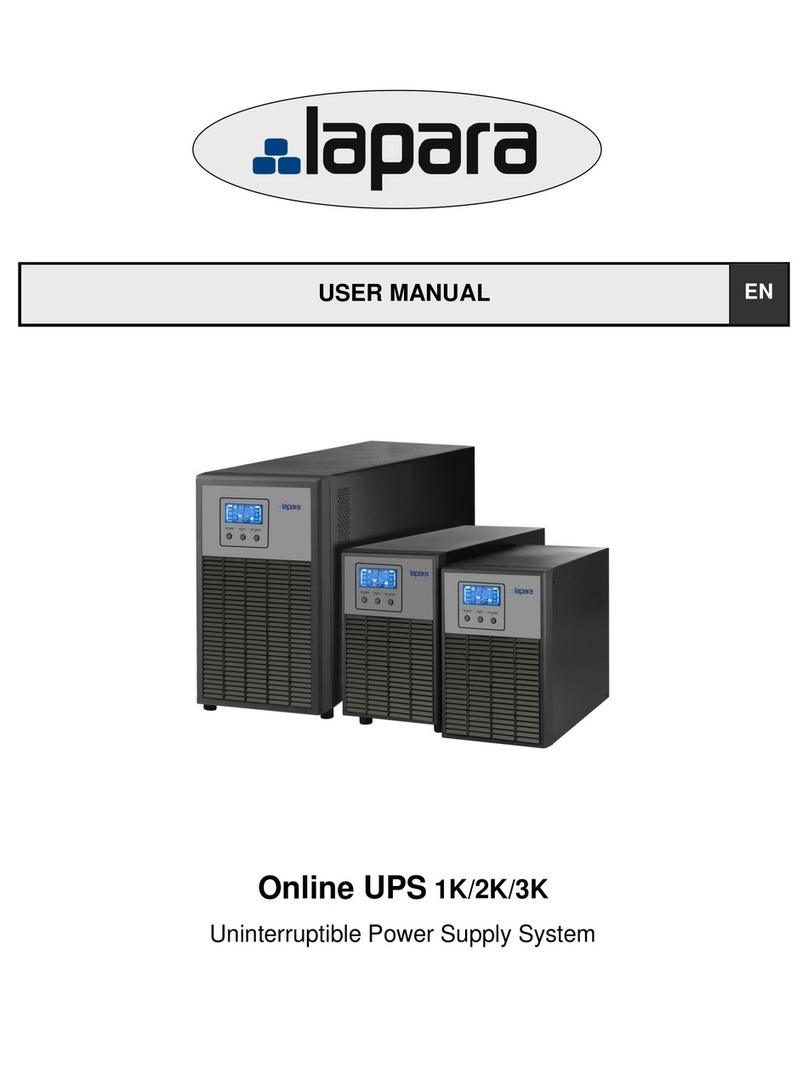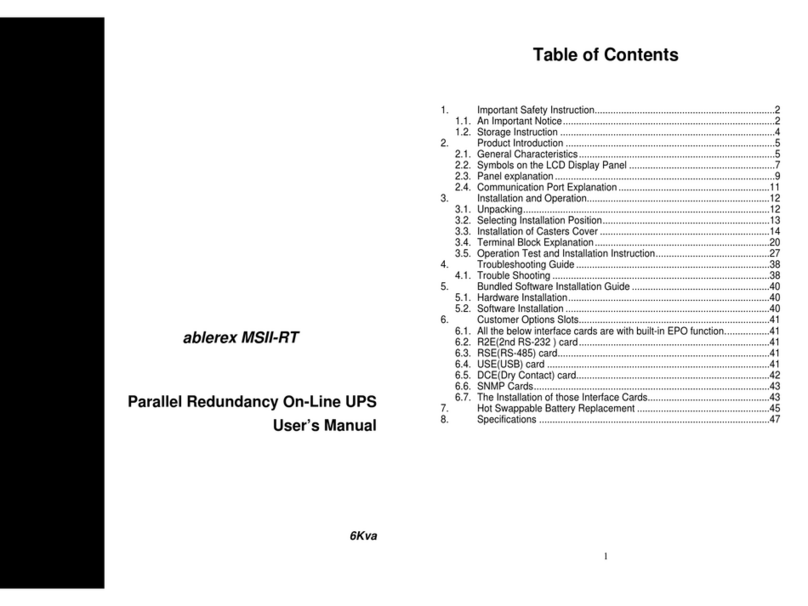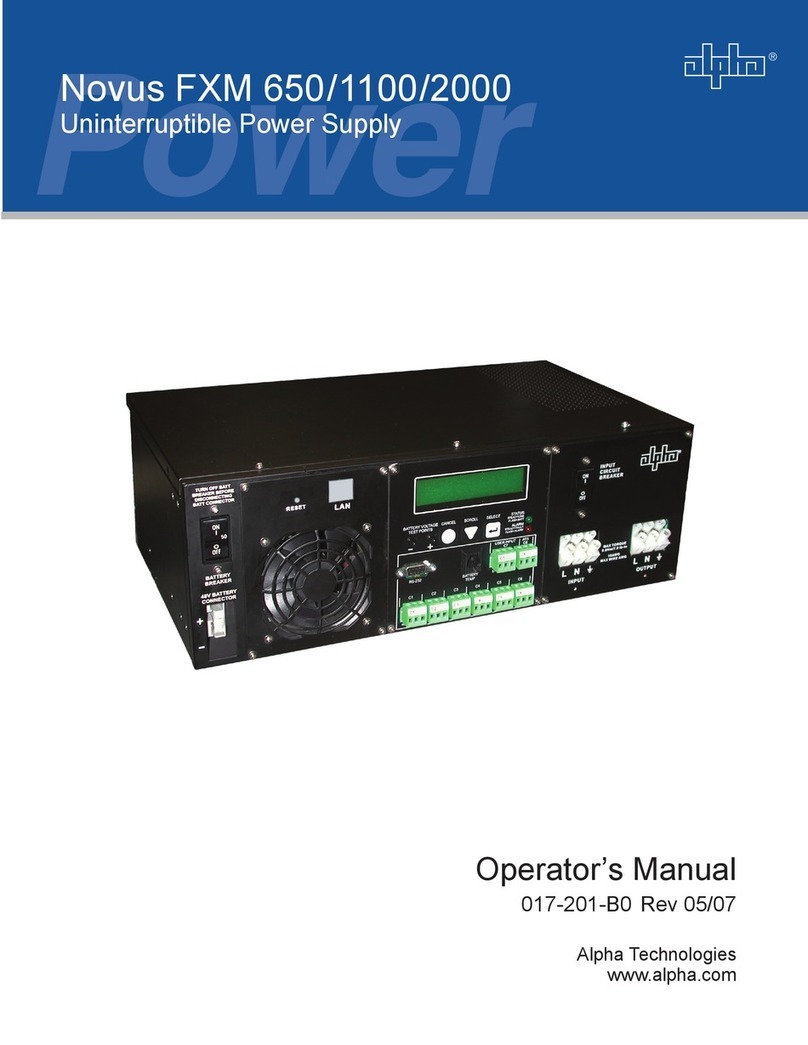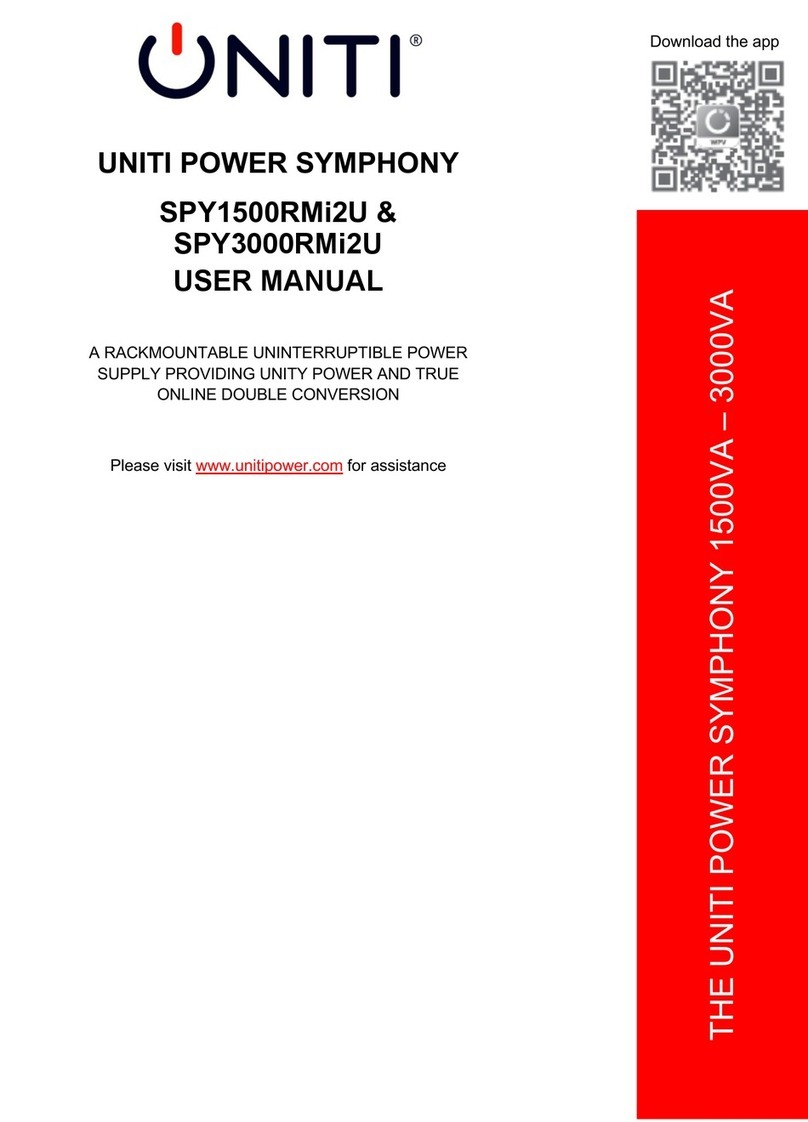SolarEdge L30US-IB80 User manual

Uninterruptable Power
Supply for 208VAC Grid
L30US-IB80, L30US-IB00,
L40US
User Guide
Version 2.0 March 2022
Cat. No. 2MUM-


ii L30US-IB80, L30US-IB00, L40US UPS
Important Notice
Copyright © July 2021 SolarEdge Inc. Doc. Part 2MUM-SG-. All rights reserved.
No part of this document may be reproduced, stored in a retrieval system, or transmitted,
in any form or by any means, electronic, mechanical, photographic, magnetic, or
otherwise, without the prior written permission of SolarEdge Inc.
All company and brand products and service names are trademarks or registered
trademarks of their respective holders.
Patent marking notice: see http://www.solaredge.com/patent
The general terms and conditions of delivery of SolarEdge shall apply.
The content of these documents is continually reviewed and amended, where necessary.
However, discrepancies cannot be excluded.
The images contained in this document are for illustrative purposes only and may vary
depending on product models.

iii L30US-IB80, L30US-IB00, L40US UPS
Thank you for choosing this uninterruptible power supply (UPS). It provides you with
protection for connected equipment. Please read this manual before installing the L series
models as it provides important information that should be followed during installation and
maintenance of the UPS and batteries, allowing you to correctly set up your system for the
maximum safety and performance. Included is information on customer support and service
if it is required. If you experience a problem with the UPS, please refer to the
Troubleshooting section in this manual to correct the problem. If the problem is not
corrected, please collect information so that the Technical Support personnel can more
effectively assist you.

iv L30US-IB80, L30US-IB00, L40US UPS
Table of Contents
1.
PREFACE ............................................................................................................................................ 1
1.1.
STANDARDS AND CONVENTIONS ............................................................................................................................................................... 1
1.2.
SAFETY SYMBOLS INFORMATION ................................................................................................................................................................ 1
1.3.
TECHNICAL SUPPORT......................................................................................................................................................................................... 2
2.
IMPORTANT SAFETY INSTRUCTIONS (SAVE THESE INSTRUCTIONS)....................................... 3
3.
MAIN FEATURES............................................................................................................................... 6
3.1.
SUMMARY ............................................................................................................................................................................................................... 6
3.2.
FUNCTIONS AND FEATURES ........................................................................................................................................................................... 6
3.3.
SYSTEM CONFIGURATION................................................................................................................................................................................ 7
3.4.
CABINET VIEW ....................................................................................................................................................................................................... 8
3.5.
DIMENSIONS AND WEIGHT......................................................................................................................................................................... 10
3.5.1.
Communication panel: ............................................................................................................... 12
3.6.
COMPUTER ACCESS ......................................................................................................................................................................................... 12
4.
OPERATION..................................................................................................................................... 15
4.1.
OPERATION MODES......................................................................................................................................................................................... 15
4.1.1.
Normal mode.................................................................................................................................................15
4.1.2.
Battery mode (Stored energy mode) ......................................................................................................15
4.1.3.
Maintenance mode (Manual bypass) ....................................................................................................16
4.1.4.
Bypass mode...................................................................................................................................................16
4.1.5.
ECO mode .......................................................................................................................................................17
4.2.
UPS OPERATION.............................................................................................................................................................................................. 18
4.2.1.
Start procedure ..............................................................................................................................................18
4.2.2.
Test procedure ...............................................................................................................................................18
4.2.3.
Maintenance bypass ....................................................................................................................................19
4.2.4.
Switch to mechanical bypass....................................................................................................................19
4.2.5.
Switch to normal operation (from mechanical bypass).............................................................. 19
4.2.6.
Cold start procedure ....................................................................................................................................20
4.2.7.
Shutdown procedure....................................................................................................................................21
4.2.8.
Parallel setting...............................................................................................................................................22
4.3.
LCD CONTROL PANEL.................................................................................................................................................................................... 25
4.3.1.
Overview..........................................................................................................................................................25
4.3.2.
Introduction ....................................................................................................................................................26
4.3.3.
Data...................................................................................................................................................................27
4.3.4.
Status ................................................................................................................................................................27
4.3.4.1. Main .............................................................................................................................................................................28
4.3.4.2. Bypass..........................................................................................................................................................................29
4.3.4.3. Output.........................................................................................................................................................................29
4.3.4.4. Battery .........................................................................................................................................................................30
4.3.4.5. Status info..................................................................................................................................................................31
4.3.5.
Alarm ................................................................................................................................................................33

iv L30US-IB80, L30US-IB00, L40US UPS
4.3.5.1. Current alarm............................................................................................................................................................33
4.3.5.2. History.........................................................................................................................................................................34
4.3.5.3. Buzzer.......................................................................................................................................................................... 34
4.3.6.
Setting...............................................................................................................................................................35
4.3.6.1. Basic setting ..............................................................................................................................................................36
4.3.6.2. Language....................................................................................................................................................................37
4.3.6.3. Password ....................................................................................................................................................................37
4.3.6.4. Brightness and backlight time............................................................................................................................38
4.3.6.5. Date and time setting............................................................................................................................................39
4.3.6.6. Communication setting ........................................................................................................................................ 39
4.3.6.7. Bypass settings......................................................................................................................................................... 40
4.3.7.
Advanced settings.........................................................................................................................................42
4.3.7.1. System setting..........................................................................................................................................................43
4.3.7.2. Parallel setting..........................................................................................................................................................45
4.3.7.3. Output setting..........................................................................................................................................................46
4.3.7.4. Battery setting ..........................................................................................................................................................47
4.3.7.5. Dry contact setup....................................................................................................................................................49
4.3.8.
Maintenance: Touch correction and battery self-test ......................................................................50
4.3.8.1. Battery self-check.................................................................................................................................................... 50
4.3.8.2. Timing daily...............................................................................................................................................................51
4.3.8.3. Timing weekly...........................................................................................................................................................51
4.3.9.
Common ..........................................................................................................................................................52
4.3.9.1. INV ON/OFF ..............................................................................................................................................................52
4.3.9.2. Battery test ................................................................................................................................................................53
4.3.9.3. Fault clear...................................................................................................................................................................54
4.3.10.
Monitor and LCD software version.........................................................................................................54
4.4.
DISPLAY MESSAGES AND TROUBLESHOOTING.................................................................................................................................... 55
4.4.1.
Operational status and mode(s) ................................................................................................. 55
4.4.2.
Faults and alarms reports........................................................................................................... 56
4.5.
OPTIONAL FEATURES ...................................................................................................................................................................................... 60
4.5.1.
SNMP card ......................................................................................................................................................60
4.5.1.1. Functions................................................................................................................................................60
4.5.2.
Relay card........................................................................................................................................................61
5.
APPENDIX 1: SPECIFICATIONS ..................................................................................................... 63
6.
APPENDIX 2: TROUBLESHOOTING .............................................................................................. 68

Table of Figures
FIGURE 1 FRONT VIEW/SIDE VIEW OF L30US-IB80, L30US-IB00 AND L40US...................................................................... 8
FIGURE 2 FRONT VIEW (WITHOUT DOOR) AND REAR VIEW OF L30US-IB80 AND L30US-IB00.................................................. 8
FIGURE 3 FRONT VIEW (WITHOUT DOOR)AND REAR VIEW OF L40US.................................................................................... 9
FIGURE 4 DIMENSIONS ................................................................................................................................................................................ 11
FIGURE 5 COMMUNICATION PANEL ............................................................................................................................................................. 12
FIGURE 6 MUSER5000 HOMEPAGE ............................................................................................................................................................ 13
FIGURE 7 MUSER5000COMMUNICATION SETTING PAGE.......................................................................................................................... 13
FIGURE 8 MUSER5000APPEND EQUIPMENT PAGE.................................................................................................................................... 14
FIGURE 9 MUSER5000APPEND EQUIPMENT MANUAL SETTING PAGE...................................................................................................... 14
FIGURE 10 NORMAL MODE .......................................................................................................................................................................... 15
FIGURE 11 BATTERY MODE .......................................................................................................................................................................... 16
FIGURE 12 MAINTENANCE MODE (MANUAL BYPASS) ....................................................................................................... 16
FIGURE 13 BYPASS MODE............................................................................................................................................................................. 17
FIGURE 14 ECO MODE ................................................................................................................................................................................. 17
FIGURE 15 COLD START BUTTON.................................................................................................................................................................. 21
FIGURE 16 MUSER5000 HOMEPAGE .......................................................................................................................................................... 22
FIGURE 17 MUSER5000 USERSETTING PAGE............................................................................................................................................. 23
FIGURE 18 MUSER5000WORK MODE SETTING PAGE................................................................................................................................ 23
FIGURE 19 MUSER5000 UPS ID SETTING PAGE ........................................................................................................................................ 24
FIGURE 20 LCD CONTROLPANEL INTRODUCTION ....................................................................................................................................... 25
FIGURE 21 SNMP CARD .............................................................................................................................................................................. 61
FIGURE 22 RELAY CONTACTS (DRYCONTACT CARD) .......................................................................................................... 61
FIGURE 23 RELAY OVERVIEW........................................................................................................................................................................ 62
vi L30US-IB80, L30US-IB00, L40US UPS

vii L30US-IB80, L30US-IB00, L40US UPS
Table of Tables
TABLE 1 BATTERIES QUANTITY ....................................................................................................................................................................... 5
TABLE 2 CABINET OVERVIEW.......................................................................................................................................................................... 9
TABLE 3: DIMENSIONS AND WEIGHTS ......................................................................................................................................................... 11
TABLE 4 COMMUNICATION PANEL ............................................................................................................................................................... 12
TABLE 5 LCD ANDLED DISPLAY................................................................................................................................................................... 25
TABLE 6 OPERATIONAL STATUS AND MODE(S) ................................................................................................................. 55
TABLE 7 FAULT INFORMATION ..................................................................................................................................................................... 56
TABLE 8 ALARM INFORMATION.................................................................................................................................................................... 58
TABLE 9 RELAY CONTACTS (COMMUNICATION CARD) ........................................................................................................ 61
TABLE 10 SPECIFICATIONS ............................................................................................................................................................................ 63
TABLE 11 PROBLEMS AND SOLUTIONS......................................................................................................................................................... 68

1L30US-IB80, L30US-IB00, L40US UPS
1.
Preface
1.1. Standards and Conventions
This User Guide contains diagrams that include images of the display screen of the UPS.
Unless otherwise indicated, the readings shown in the screen images are only illustrative and
are not intended to match the readings on a specific system in any particular environment.
Operation and control of the L Family UPSes are performed through a touch-sensitive LCD
display screen. In this manual, when explaining how to navigate the control software via the
touch-sensitive screen, the terms "tap", "press", "choose", and "select" may be used
interchangeably to indicate selection of a screen option.
Most of the electrical abbreviations in this document are according to IEEE 280 Standard
Letter Symbols for Quantities Used in Electrical Science and Electrical Engineering.
1.2. Safety Symbols Information
The following safety symbols are used in this document. Familiarize yourself with the
symbols and their meaning before installing or operating the system.
NOTE!
Denotes additional information about the current subject.
CAUTION!
Denotes a caution. It calls attention to a procedure that, if not correctly
performed or adhered to, could result in damage to the unit or load. Do not
proceed beyond a caution note until the indicated conditions are fully
understood and met.
WARNING!
Denotes a warning. It calls attention to a procedure that, if not correctly
performed or adhered to, could result in injury or loss of life. Do not proceed
beyond a warning note until the indicated conditions are fully understood and
met.

2L30US-IB80, L30US-IB00, L40US UPS
WARNING - RISK OF LETHAL ELECTRIC SHOCK!
Denotes an electrical hazard. It calls attention to a procedure that, if not
correctly performed or adhered to, could result in injury or loss of life. Do not
proceed beyond a warning note until the indicated conditions are fully
understood and met.
1.3. Technical Support
You can contact technical support via any of the following methods:
SOLAREDGE Inc. - Critical Power Service Department
Available via email at [email protected]
Phone support
US
Available 24 * 7 * 365 by phone at (510) 498 3333.
Other regions
Available 24 * 7 * 365 by phone at (972) 73 2403139

3L30US-IB80, L30US-IB00, L40US UPS
2.
Important Safety Instructions (Save These Instructions)
SAVE THESE INSTRUCTIONS! This manual contains important instructions, for models
L30US-IB80, L30US-IB00, and L40US, that should be followed during installation and
maintenance of the UPS and batteries.
CAUTION!
To reduce the risk of fire, connect only to a circuit provided with DC 160
amperes (for 30kVA External DC Circuit Overcurrent Protective Device) or with
DC 200 amperes (for 40kVA External DC Circuit Overcurrent Protective Device)
maximum branch circuit over current protection in accordance with the
National Electric Code, ANSI/NFPA 70”.
A label of this text, or equivalent text in your language, must be installed on the UPS and on
the backfeed isolator protection if it is installed remotely from the UPS.
CAUTION! (UPS having internal batteries): Risk of electrical shock – Hazardous
live parts inside this unit are energized from the battery supply even when the
input AC power is disconnected.
CAUTION! (No user-serviceable parts): Risk of electrical shock, do not remove
cover. No user serviceable parts inside. Refer servicing to qualified service
personnel.
CAUTION! (Non-isolated battery supply): Risk of electric shock, battery circuit is
not isolated from AC input, hazardous voltage may exist between battery
terminals and ground. Test before touching.
WARNING! (Fuses): To reduce the risk of fire, replace only with the same type
and size of fuse.
WARNING! Unit intended for installation in a controlled environment.
WARNING! Do not dispose of batteries to a fire, the battery may explode.
WARNING! When backfeed protection is needed by local area regulations and codes, please
note that it is not a part of the system design and you must install an external automatic
isolation device on site, in order to prevent dangerous voltage or energy at the input of the
isolation device. The device must be rated according to the system specifications and must
open within 15 seconds after the upstream power supply fails. HAZARD! If those
instructions are not followed it may cause death or serious injury.

4L30US-IB80, L30US-IB00, L40US UPS
CAUTION! Do not open or damage the battery, released electrolyte is harmful
to the skin and eyes.
CAUTION! A battery can present a risk of electric shock and high short circuit
current. The following precautions should be observed when working on
batteries: remove watches, rings, or other metal objects, use tools with
insulated handles.
To reduce the risk of electric shock, disconnect the UPS from the main supply
before installing a computer interface signal cable. Reconnect the power cord
only after signaling interconnections have been made.
Servicing of batteries should be performed or supervised by personnel with
knowledge of batteries and required precautions. Keep unauthorized personnel
away from batteries.
For Replacement of batteries located in a service access area:
1. Servicing of batteries should be performed or supervised by personnel
knowledgeable about batteries and the required precautions.
2. Risk of explosion if battery is replaced by an incorrect type. When
replacing batteries, replace with the same type and number of batteries or
battery packs.
3. CAUTION: Do not dispose of batteries in a fire. The batteries may
explode. Dispose of used batteries according to the instructions.
4. CAUTION: Do not open or damage batteries. Released electrolyte is
harmful to the skin and eyes. It may be toxic.
5. CAUTION: A battery can present a risk of electrical shock and high short
circuit current. The following precautions should be observed when working on
batteries:
•Remove watches, rings, or other metal objects.
•Use tools with insulated handles.
•Wear rubber gloves and boots.
•Do not lay tools or metal parts on top of batteries.
•Disconnect charging source prior to connecting or disconnecting
battery terminals.

5L30US-IB80, L30US-IB00, L40US UPS
•Check if the battery is inadvertently grounded. If it is, remove the source
from ground. Contact with any part of a grounded battery can result in
electrical shock. The likelihood of such shock can be reduced if such grounds
are removed during installation and maintenance.
These UPS units are extremely heavy. Caution should be taken in moving and
positioning this equipment. These safety instructions are important and should
be precisely followed during installation, operation, and maintenance of the
UPS and batteries.
CAUTION!
The unit carries hazardous voltage. When the UPS is on, its outlets may carry
hazardous voltage even when not plugged into the wall outlet, because the
battery may continue to supply power.
Care should be taken to install the UPS in an indoor environment which is
under temperature and humidity control, free from electrically conductive
particles, with reduced risk of electric shock.
It is best to disconnect the device using the power supply cord. Ensure that the
equipment is placed in a position near the easily accessible outlet.
Except for replacing the batteries, all servicing on this equipment must be
carried out by qualified service personnel.
Before conducting any maintenance, repair, or shipment, first ensure that all the
UPS equipment is completely turned off and disconnected.
For additional safety instructions, see Safety section of the Service Manual.
Table 1 Batteries Quantity
Model Rating SolarEdge P/N Description
L30US-IB80 30 kVA L30IBUS-L6G4V09001 L30US 3PH 4W UPS 208V 30KVA/30KW IB80
L30US-IB00 30 kVA L30IBUS-L6G0V09001 L30US 3PH 4W UPS 208V 30KVA/30KW IB00
L40US 40 kVA L40US-L6G0VNN001 L40US 3PH 4W UPS 208V 40KVA/40KW IB00

6L30US-IB80, L30US-IB00, L40US UPS
3.
Main features
3.1. Summary
This series UPS is a 3-phase input/ 3-phase output high frequency online UPS.
This UPS can solve most of the power supply problems, such as blackout, over-voltage,
under-voltage, voltage sudden drop, oscillating of decreasing extent, high voltage pulse,
voltage fluctuation, surge, inrush current, harmonic distortion (THD), noise interference,
frequency fluctuation, etc.
This UPS can be applied to different applications from computer device, automatic
equipment, communication system to industry equipment.
3.2. Functions and Features
3 Phase In/3 Phase Out UPS
This UPS is a 3 Phase In/3 Phase Out high-density UPS system, of which input current is kept
in balance. No unbalance problem might occur.
Digital Control
This series UPS is controlled by its Digital Signal Processor (DSP)providing increased
reliability, optimized performance, self-protection, self-diagnostics and many more.
Battery is Configurable
The battery pack of this series UPS is configured to 20 blocks.
Charging Current is configurable
Through the UPS user interface, the user may set the capacity of the batteries as well as
reasonable charging currentand maximum charging current. Constant voltage mode,
constant current mode, or floating are easily switchable.
Intelligent Charging Method
The series UPS adopts advanced three-stage charging method:
1st stage: High Current Constant Current charging to guarantee charging back to 90%.
2nd-stage: Constant Voltage in order to vitalize battery and make sure batteries are fully
charged.
3rd stage: Floating mode.
This 3-stage charging method will extend life of the batteries and guarantee fast charging.

7L30US-IB80, L30US-IB00, L40US UPS
LCD display
With LCD and LED displays, the user may easily understand the UPS status and its
operational parameters, such as input/output voltage, frequency and load status, battery
status, ambient temperature, etc.
Intelligent monitoring function
Using the optional SNMP Card (optional for extra charge), you may remotely control and
monitor the UPS.
REPO function
Remote EPO (REPO) function is available for this UPS series.
3.3. System configuration
UPS device and external or internal batteries make up the system. Depending on the site and
load requirements of the specific installation, certain additional options are available for the
solution.
Planning a UPS system, the following should be taken into consideration:
The total demand of the protected system shall dictate the output power rating (VA).
Allow a margin for future expansion or calculation of inaccuracies from measured power
requirements.
Backup time required will indicate the battery size needed. If the load is less than the UPS
nominal power rating, then the actual backup time is longer.
The following options are available with extra charge:
SNMP/WEB card
Relay card

8L30US-IB80, L30US-IB00, L40US UPS
3.4. Cabinet view
Figure 1 Front view/Side view of L30US-IB80, L30US-IB00 and L40US
Figure 2 Front view (without door) and Rear View of L30US-IB80 and L30US-IB00

9L30US-IB80, L30US-IB00, L40US UPS
Figure 3 Front view (without door) and Rear View of L40US
Table 2 Cabinet overview
(1) LCD panel (2) Front door and lock
(3) Mains input breaker (4) Bypass input breaker
(5) Maintenance breaker cover (6) Maintenance breaker
(7) Output breaker (8) Communication panel
(9) Rear cover (10) Terminal block cover

10 L30US-IB80, L30US-IB00, L40US UPS
3.5. Dimensions and Weight
Figure 4 Dimensions

11 L30US-IB80, L30US-IB00, L40US UPS
Table 3: Dimensions and Weights
Model Width Depth Height Weight
L30US-IB80 400mm (15.75”) 935mm (36.8”) 1065mm (41.9”) 374kg (825lb)
L30US-IB00 400mm (15.75”) 935mm (36.8”) 1065mm (41.9”) 162kg (357lb)
L40US 400mm (15.75”) 935mm (36.8”) 1065mm (41.9”) 145kg (320lb)

12 L30US-IB80, L30US-IB00, L40US UPS
3.5.1. Communication panel:
Figure 5 Communication panel
Table 4 Communication panel
(1) Parallel ports (2) LBS port (for parallel connection)
(3) REPO port 12VDC/ 15mA (4) MAINTAIN-AUXSWS port 12VDC/ 15mA
(5) Optional port for backfeed protection
120VDC/ 150mA
(6) BAT_SW: detects battery switch status,
normally open, 12VDC/ 15mA.
(7) RS232 port (8) USB port
(9) RS485 port (for temperature sensor) (10) Battery temperature sensor (NTC)
(11) Cold-start button (12) Intelligent Slot 1 (SNMP card/ Relay card)
(13) Intelligent Slot 2 (SNMP card/ Relay card)
3.6. Computer access
1. With the USB cable, connect the USB port of the UPS to the computer.
2. Open the Muser5000 software, click the System button.
Other manuals for L30US-IB80
1
This manual suits for next models
2
Table of contents
Other SolarEdge UPS manuals

